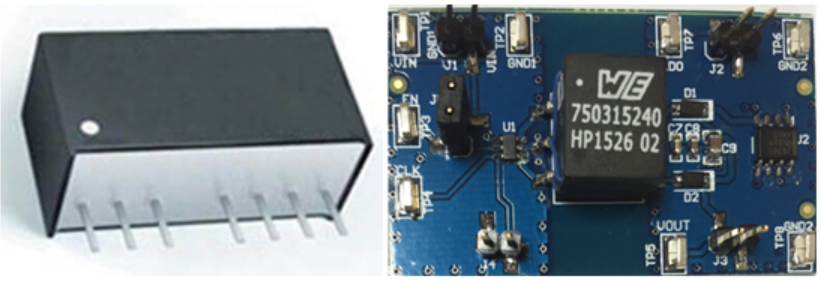SSZT197 february 2021 UCC12051-Q1
Faced with shrinking space constraints and increased robustness requirements, industrial and automotive power-supply designers must carefully choose the best power design topologies to meet their application needs. Isolated choices include modules as well as discrete and integrated solutions; each has its own trade-offs. Modules are encapsulated solutions with common input/output requirements, but they have limited temperature and isolation ratings. Discrete solutions are customized designs using individual components, but they require a large engineering effort. Integrated solutions use transformers inside the package for a lower profile solution, but they have lower power outputs.
Modules and discrete solutions use transformers or inductors to convert electric energy. The transformer is a tall component, which causes modules and discrete solutions to have significant height. Figure 1 shows a 3D view of a module and a top-down view of a discrete solution.
 Figure 1 Isolated power solutions:
module on the left, discrete on the right
Figure 1 Isolated power solutions:
module on the left, discrete on the rightApplications requiring low board thickness are limited by the height of the solution. For example, telecommunication racks use slotted cards to add or replace servers. The thinner these cards are, the more server slots can fit in each rack. Industries like telecommunications and consumer electronics pushing for low-profile designs can benefit from a thin, integrated power solution.
Thin solutions have a mechanical advantage as well. Compared to other printed circuit board (PCB) components, transformers are tall – like a high-rise in the middle of a residential community. These tall components act like cantilevers and are susceptible to strong physical perturbations on the PCB, just like a high-rise in an earthquake. Cantilever vibration modes lead to lateral stresses at the top of the component, as illustrated in Figure 2.
 Figure 2 Discrete solution with
transformer flexibility illustrated in white
Figure 2 Discrete solution with
transformer flexibility illustrated in whiteLateral stress can cause transformer pads to lift or components to desolder from the PCB. This can be a huge reliability issue in rugged application environments that will experience impacts and vibrations. For example, isolated drivers powering AC motors can experience vibrations related to motor speeds during operation. If the vibrations get too violent, a motor can cause its own failure by disconnecting the transformer from its power-stage gate driver.
Even with minimal vibrations, one unexpected impact can potentially disable motor drives. Imagine in factory automation that an impact causes a motor failure, slowing down or stopping production. Or for an electric vehicle, hitting a speed bump too fast could potentially disable the electric motor. Thin, low-profile designs are critical for circuit lifetime reliability in environments with vibrations and impacts, such as automotive electric motors and industrial automation.
TI's UCC12051-Q1 is an integrated isolated DC/DC converter that leverages transformer-in-package technology, providing 500 mW of isolated power in a low-profile 16 pin small-outline integrated circuit (SOIC16-DW) package. The device is operable in extended ambient temperatures from -40°C to 125°C and features 5-kV reinforced isolation.
Thin board designs allow for smaller, denser systems, and are more mechanically robust to vibrations and perturbations. The UCC12051-Q1 enables low-profile power for thinner board designs compared to modules and integrated solutions. Medical and consumer industries can benefit from lower profiles systems, and telecommunication and industrial industries can benefit from increased reliability and power density.